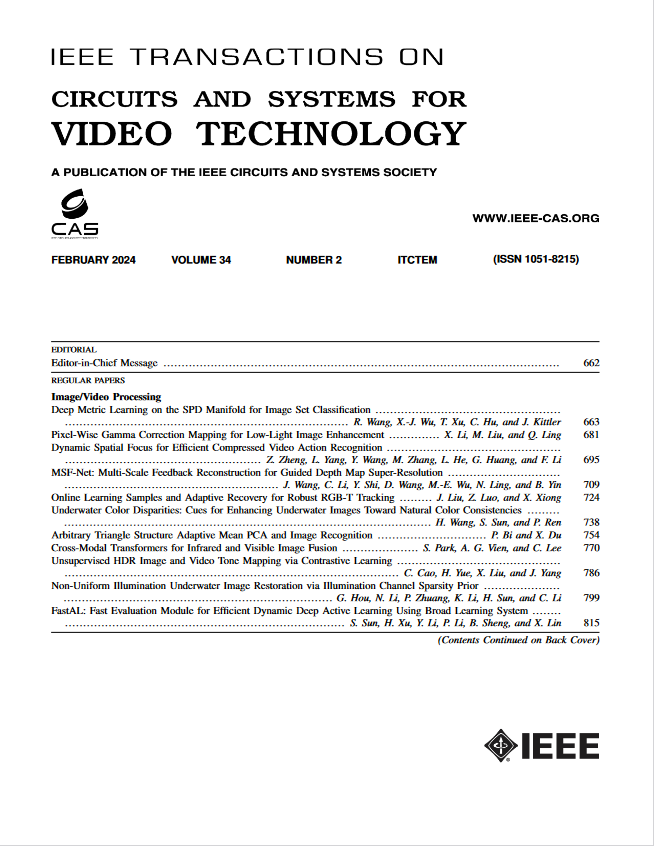基于批量规范的弱监督视频异常检测
IF 8.3
1区 工程技术
Q1 ENGINEERING, ELECTRICAL & ELECTRONIC
IEEE Transactions on Circuits and Systems for Video Technology
Pub Date : 2024-08-27
DOI:10.1109/TCSVT.2024.3450734
引用次数: 0
摘要
在弱监督视频异常检测(WVAD)中,只有表明异常事件存在或不存在的视频级别标签可用,主要挑战来自异常事件时间注释中固有的模糊性。基于异常事件的时间特征往往表现出离群值特征的统计学洞察力,我们提出了一种将BatchNorm引入WVAD的新方法BN-WVAD。在提出的BN-WVAD中,我们利用BatchNorm的均值向量发散度(Divergence of Feature from Mean vector, DFM)作为可靠的异常准则来识别异常视频中的潜在异常片段。所提出的DFM标准对于异常识别也具有区别性,并且对标签噪声更有弹性,可以作为额外的异常评分来修正易受噪声标签影响的异常分类器的预测。此外,还设计了一种批级选择策略,以过滤视频中出现更多异常事件的更多异常片段。提出的BN-WVAD模型在UCF-Crime和XD-Violence上显示了最先进的性能,AUC为87.24%,AP高达84.93%。我们的代码实现可以在https://github.com/cool-xuan/BN-WVAD上访问。本文章由计算机程序翻译,如有差异,请以英文原文为准。
BatchNorm-Based Weakly Supervised Video Anomaly Detection
In weakly supervised video anomaly detection (WVAD), where only video-level labels indicating the presence or absence of abnormal events are available, the primary challenge arises from the inherent ambiguity in temporal annotations of abnormal occurrences. Inspired by the statistical insight that temporal features of abnormal events often exhibit outlier characteristics, we propose a novel method, BN-WVAD, which incorporates BatchNorm into WVAD. In the proposed BN-WVAD, we leverage the Divergence of Feature from the Mean vector (DFM) of BatchNorm as a reliable abnormality criterion to discern potential abnormal snippets in abnormal videos. The proposed DFM criterion is also discriminative for anomaly recognition and more resilient to label noise, serving as the additional anomaly score to amend the prediction of the anomaly classifier that is susceptible to noisy labels. Moreover, a batch-level selection strategy is devised to filter more abnormal snippets in videos where more abnormal events occur. The proposed BN-WVAD model demonstrates state-of-the-art performance on UCF-Crime with an AUC of 87.24%, and XD-Violence, where AP reaches up to 84.93%. Our code implementation is accessible at
https://github.com/cool-xuan/BN-WVAD
.
求助全文
通过发布文献求助,成功后即可免费获取论文全文。
去求助
来源期刊
CiteScore
13.80
自引率
27.40%
发文量
660
审稿时长
5 months
期刊介绍:
The IEEE Transactions on Circuits and Systems for Video Technology (TCSVT) is dedicated to covering all aspects of video technologies from a circuits and systems perspective. We encourage submissions of general, theoretical, and application-oriented papers related to image and video acquisition, representation, presentation, and display. Additionally, we welcome contributions in areas such as processing, filtering, and transforms; analysis and synthesis; learning and understanding; compression, transmission, communication, and networking; as well as storage, retrieval, indexing, and search. Furthermore, papers focusing on hardware and software design and implementation are highly valued. Join us in advancing the field of video technology through innovative research and insights.

 求助内容:
求助内容: 应助结果提醒方式:
应助结果提醒方式:


